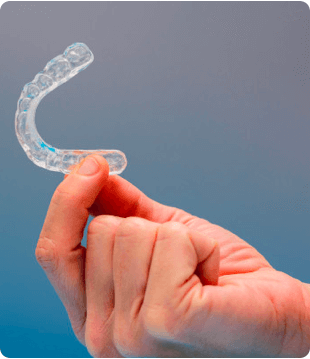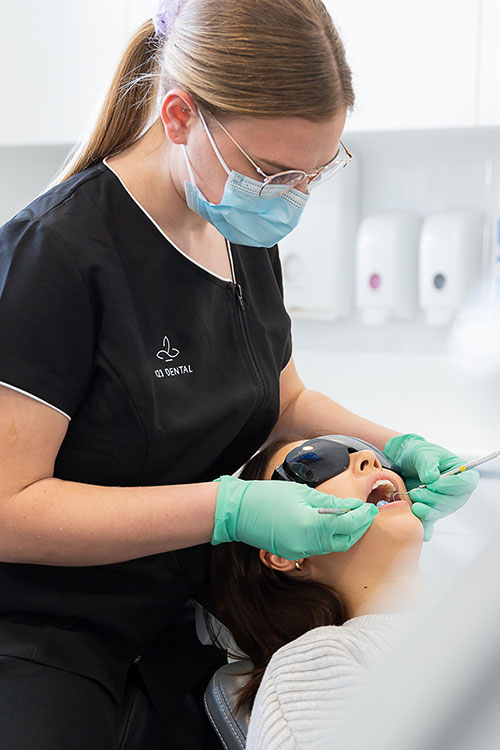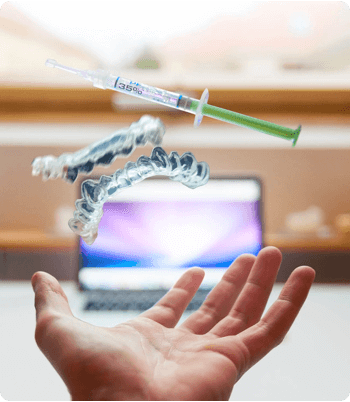What is a Bite Splint?
Teeth grinding or clenching is a big problem for many people everywhere. It’s often referred to simply as ‘bruxism.’ If you unknowingly grind your teeth during sleep, then you may have sleep bruxism and therefore may benefit from the assistance of a bite splint. There are also some people who grind their teeth while they’re fully alert and awake. They have a condition that’s called awake bruxism.
Bite splits can be immensely helpful to people who clench their teeth while they’re asleep. They have smooth interior surfaces that remain next to the gums and the teeth. These appliances’ exterior surfaces are tough, fully transparent and sturdy.
They can just as easily assist those who have TMJ disorders. These disorders negatively interfere with the joints and chewing muscles that serve as the pathways between skulls and lower jaws.

How Are They Made?
Bite splints are made using plastic. Dentists place them straight on top of the upper teeth. They enable the teeth to remain in their appropriate positions. These appliances can alter how the teeth bite when they merge. They, because of that, help minimise teeth wear.
People who have persistent teeth grinding and clenching patterns are usually prone to severe wear. These bruxism splints have textures that are markedly softer than those of natural teeth. That’s the reason they can be so effective in keeping grinding and clenching habits under control. These splints can also minimise jaw joint strain and pressure. They can minimise jaw muscle burden and even lessen pain. If you suffer from jaw muscle and joint aching, then a bite splint may be a smart solution for you.
What Are the Benefits Bruxism Splint?
Bite splints are given to patients for a variety of reasons. In fact, with proper use, a bite splint can:
- Protect the teeth, porcelain veneers, and other dental restorations
- Adjust the position of the jaw joint
- Allow the jaw muscles to rest
- Reduce teeth clenching and grinding
- Improve airway space
- Provide valuable diagnostic information regarding joint problems
Needless to say, there are plenty of benefits of wearing a bite splint. Generally, bite splints are used to simultaneously perform several, if not all, of the above functions.
By actively protecting your teeth or restorations, the right bite splint can minimise damage and pain while we diagnose the problems associated with your specific bite.
Since teeth clenching may be the result of your jaw trying to settle into the best resting position, a bite splint can also reduce your teeth clenching tendencies.

Speak to Our Team About Your Teeth Grinding Today!
Get in touch with us and we can book you in for your bite splint!
Are There Different Types of Bite Splints?
There are several different types of bite splints designed to accomplish several or all of these goals. Your dentist may select from many different designs depending on the specific reasons for your needing such a device

Some of the different types of bite splints to treat bruxism include:
1. Permissive Bite Splints
Permissive bite splints are the most commonly prescribed. They are specifically designed to give your jaws the ability to move freely in relation to one another. These types of bite splints can be fitted to either the lower or upper teeth, and they are primarily prescribed to protect the teeth or restorations. However, they can also be used to provide helpful diagnostic information. Permissive bite splints have a smooth and fairly flat biting surface. When the jaw closes, the teeth that come into contact with it are able to freely slide against the surface, allowing the jaw muscles to close the jaw without deflective tooth inclines that prevent normal, pain-free muscle activity.
2. Non-Permissive Bite Splints
Unlike permissive bite splints, non-permissive bite splints are designed to restrict the movement of the jaws in relation to one another. In other words, they lock the upper and lower jaw into position, limiting their ability to slip into a position that will cause damage and pain.
3. Directive Bite Splints
Directive bite splints are less common and typically only used to help treat specific jaw joint structural disorders. The design of these splints allows them to direct the jaw joints into a specific socket position in order to enhance and expedite the healing process. Despite their effectiveness, directive bite splints must be used extremely cautiously and only after a thorough examination has been performed to determine the joint’s specific structural problem.
4. Full and Partial Arch Bite Splints
Full arch bite splints are made to completely fit seamlessly over the entire arch of the lower or upper teeth. Conversely, partial arch bite splints are designed to partially fit over the arch. As such, partial arch splints can be quite small and only fit between a few teeth.
Call Us For Your Bite Splint
We’re perth’s leading bite splint experts, no matter your questions or issues, we can help all of your dental needs.
Are Bite Splints Difficult to Clean and Maintain?
Cleaning a bite splint and keeping it hygienic isn’t difficult at all. In fact, it can be done with minimal time and effort. You can even clean a bite splint with a basic toothbrush.
With proper basic care and maintenance, most bite splints can remain in fine working condition for up to five years.

Interested in Learning More About Bite Splints?
Contact 123 Dental for more information and to discuss your dental options today!
Bite Splint FAQ
Get all the answers about Bit Splits you need!



 Hi, you’re chatting with Chloe. If you could please fill out all your details below, I will be in contact with you shortly.
Hi, you’re chatting with Chloe. If you could please fill out all your details below, I will be in contact with you shortly.